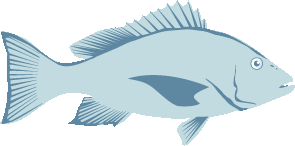Overview
The fishery of the red snapper (Lutjanus campechanus) is one of the most important in terms of the scale resource in the Gulf of Mexico (GM) region, being the fifth species of fish with greater extraction in Campeche (González-de la Rosa, Sánchez and Arreguín-Sánchez, 1994; Government of the State of Campeche, 2015).
During the decade of the 70s, the annual catch of red snapper in this same region was represented in 93% by L. campechanus, without indications of reduction of the population stock (Anderson et al. 2015). During the 80s, González-de la Rosa et al. (1994), Monroy-García, Garduño-Andrade and Espinosa (2002), as well as, Monroy-García, Arceo and Ríos (2004) stated that the red snapper resource was under-exploited and the fishery growing in the north from Yucatan, showing an increase in annual catches from 1,800.0 to 4,500.0 tonnes.
In Mexico, there was a historical maximum in the catch of red snapper during 1993. In the period 1986-1996, 4,956.0 t of the average annual catch was recorded and from 2000 to 2015 a decrease of 39.0% was observed with 2,996.0 t annual average according to the CNP (2018).
Despite the commercial importance of this resource, there are currently no biomass studies in the region. Monroy García et al. (2002) estimated that this indicator decreased from 32,957.0 t in 1984 to 16,877.0 in 1999, which is 51.0%, indicating that this population does not show signs of recovery. They also calculated a maximum sustainable yield (RMS) of 1,271.0 t / year. Recording a capture of 3,083.0 t in 1992, and an average of 1,384.0 t in the period 1984-1999, which exceeds the CMS and therefore there is a strong decrease, reporting that landings in the Gulf of Mexico (GM) declined from 71.0 to 80.0% by 2013 (Anderson et al., 2015).
Currently, in the Mexican states, the use of this resource does not present specific regulations such as a fishing management plan, reproductive closures, quotas or minimum catch sizes, which has influenced the decline in populations and therefore the availability of this resource, considering that it is currently deteriorating in the states of Tamaulipas, Veracruz, Campeche and Yucatan and at the level of maximum sustainable use in Tabasco (Anderson et al., 2015; CNP, 2018), the development of strategies for fishery management for this species, which involve the fisheries, government, academic and civil society organizations in order to establish standards for responsible fishing.
The fishery of the red snapper (Lutjanus campechanus) is one of the most important in terms of the scale resource in the Gulf of Mexico (GM) region, being the fifth species of fish with greater extraction in Campeche (González-de la Rosa,
Objectives
By the end of 2024, the FIP aims to achieve a management performance in accordance with all the 28 MSC indicators for sustainable fisheries. This FIP is also working towards completing the following objectives:
Implement a continuous monitoring program that permit generate basic fishery information of the red snapper stocks (September 2019 - December 2024).
Analyze the fishery impact on the ecosystem, habitat and associated species, to improve its management (January 2020 - December 2024).
Design and promote a quota management program with an ecosystem approach to mitigate fishing pressure (January 2021 - December 2024).
A red snapper advisor committee will be created, which will allow strengthens decisionmaking processes (January 2022 - December 2023).
Create a specific management program to the fishery that allows achieving the development of fishery regulations and improvements in compliance, such as the progressive recovery of the stock of red snapper (January 2021 - December 2024).
Additional objectives to the MSC standard:
Generate financial and political support, from collaboration among stakeholders (August 2019 - December 2024).
Share research results and improvements obtained through workshops, scientific publications and other materials to research and decision-making processes (January 2021 - December 2024).
FIP at a Glance
| 32% | 39% | 29% |
This pie chart represents completed environmental actions. Non-completed environmental actions may contain completed sub-tasks that are not illustrated here. For more information on environmental action progress visit the Actions Progress tab.
- Complete
- Incomplete

